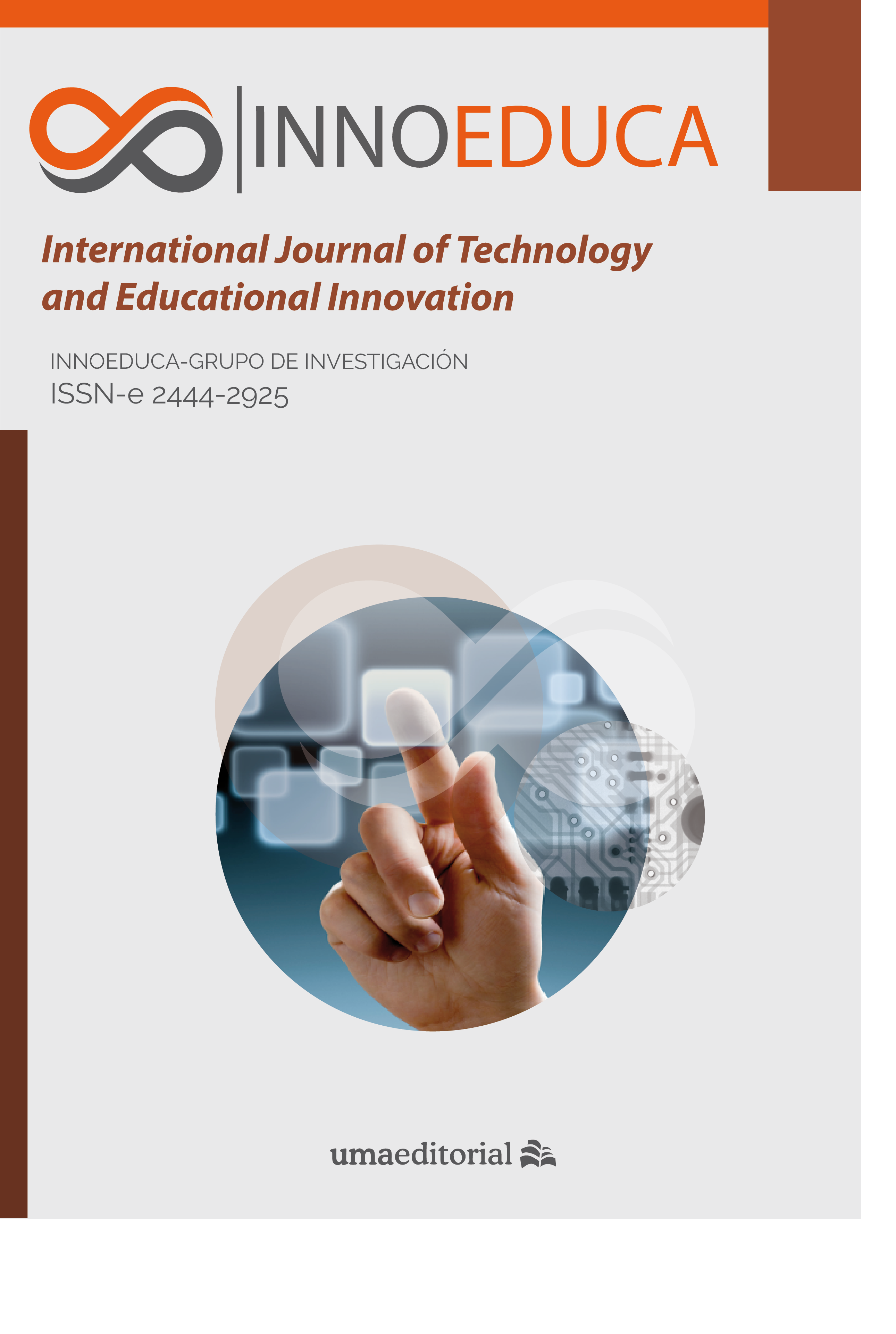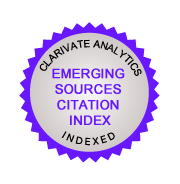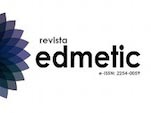The role of the university against the abandonment of studies. Pre-university training based on innovation and creativity workshops
DOI:
https://doi.org/10.24310/innoeduca.2020.v6i1.4412Abstract
The choice of the university studies becomes one of the problems that many young people face when they finish their secondary education or training cycles. The high dropout rate of university studies in Spain, especially in the first academic years, reflects possible inadequate choices and imbalances between the expectations created and the reality the students find. According to data from the Spanish Ministry of Education, Culture and Sports, the abandonment of studies affects almost 20% of the total of students (academic year 2013-2014) which reveals the need to address this situation, by seeking solutions and new preventive measures.
There are many researches that have analyzed the causes of this university dropout trying to establish effective prevention measures. Many of these studies agree on the importance of the role of the university itself in the preparation of the insertion of high school students or training cycles.
The main objective of this research is to investigate the possibilities of collaboration between secondary education centers and university centers, focusing on new collaborative models of innovation and creativity in the stage prior to entering university. The most important contribution is translated into showing a real experience of practical and interactive workshops between high school students with high capacities and students and professors of the Architecture degree.
The objectives of the workshops are the following ones: firstly, to introduce the student to the field of knowledge of Architecture. Secondly, to explain the importance of studies in today's society and, thirdly, to awaken vocations among others. In order to achieve these goals, a methodology based on interactive workshops that promote teamwork and student creativity has been carried out. The results of this experience have been satisfactory, both the evaluation of the survey made to the participants and the evaluation of the mentors of the program.
Downloads
Metrics
References
Araque, F., Roldán, C., & Salguero, A. (2009). Factors influencing university drop out rates. Computers and Education, 53(3), 563–574. Retrieved from http://www.sciencedirect.com/science/article/pii/S0360131509000815?via%3Dihub
Balderrama, M. (2005). Creatividad y Aprendizaje (Editorial). Lima.
Bernardo, A. B., Cerezo, R., Núñez, J. C., Tuero, E., & Esteban, M. (2015). Predicción del abandono universitario: variables explicativas y medidas de prevención. Revista Fuentes, 16, 63–84. Retrieved from ttp://institucional.us.es/revistas/fuente/16/PREDICCIÓN DEL ABANDONO UNIVERSITARIO.pdf
Corominas Rovira, E. (2001). La transición a los Estudios Universitarios. Abandono o cambio en el primer año de Universidad. Revista de Investigación Educativa, 19(1), 127–151. Retrieved from https://core.ac.uk/download/pdf/132556546.pdf
Datos básicos del sistema universitario español. Curso 2013-2014. Catálogo de publicaciones del Ministerio: mecd.gob.es. (2013). Retrieved from https://www.mecd.gob.es/prensa-mecd/dms/mecd/prensa-mecd/actualidad/2014/02/20140213-datos-univer/datos-cifras-13-14.pdf
Domínguez Martín, R., Cruz Chust, A. M., & Ferrando Rodríguez, M. L. (2018). Implementando el coaching educativo en la universidad virtual, una herramienta de desarrollo personal. Innoeduca. International Journal of Technology and Educational Innovation; Vol. 4, Núm. 2 (2018)DO - 10.24310/Innoeduca.2018.V4i2.4930 . Retrieved from http://www.revistas.uma.es/index.php/innoeduca/article/view/4930/5041
García Félix, Eloina; Conejero Casares, J. Alberto; Díez Ruano, J. L. (2014). La entrada en la Universidad: un reto para la orientación académica. Revista de Docencia Universitaria-REDU, 12(2), 255–280.
Llibrer Escrig, Inmaculada; Latorre Guillem, M. Á. (2016). Asistencia a clase en el espacio europeo de educació superior. Opción, 12, 1052–1074.
López de la Serna, A., Castaño Garrido, C., & Herrero Fernández, D. (2018). Integración de los cursos SPOC en las asignaturas de grado. Una experiencia práctica. Píxel-Bit. Revista de Medios y Educación; Núm. 52 (2018). Retrieved from https://recyt.fecyt.es/index.php/pixel/article/view/62528
Martín Romera, A., Berrios Aguayo, B., & Pantoja Vallejo, A. (2019). Factores y elementos de calidad percibidos por el profesorado participante en el plan de acción tutorial de universidades europeas. Educación XX1; Vol. 23, Núm. 1 (2020). https://doi.org/10.5944/educxx1.23874
Martínez-Berruezo, María Ángeles; García-Varela, A. B. (2013). Volver Análisis de la influencia de la virtualización en la motivación del alumnado universitario de primer curso de Magisterio. Revista de Educación, 362(Sept.-Dic), 42–68. https://doi.org/10.4438/1988-592X-RE-2011-362-152
Martínez, M. (2009). La orientación y la tutoría en la universidad en el marco del Espacio Europeo de Educación Superior (EEES). Revista Fuentes, 9, 78–97. Retrieved from http://institucional.us.es/revistas/fuente/9/art_4.pdf
Martínez Ramón, Juan Pedro; Gómez Barba, F. (2010). La técnica puzzle de Aronson: descripción y desarrollo. In P. . Arnaiz & F. J. (Coords. . Hurtado, Ma.D. y Soto (Eds.), 25 Años de Integración Escolar en España: Tecnología e Inclusión en el ámbito educativo, laboral y comunitario (Consejería). Murcia.
Ministerio de Educación, C. y D. (2016). Datos y Cifras del sistema universitario español. Curso 2015 2016. Catálogo de Publicaciones Del Ministerior: Mecd.Gob.Es. Retrieved from https://www.mecd.gob.es/dms/mecd/servicios-al-ciudadano-mecd/estadisticas/educacion/universitaria/datos-cifras/datos-y-cifras-SUE-2015-16-web-.pdf
Oliver, Amparo; Vivo, Juana María; Galiana, L. (2013). Determining Asessment Performance in Applied Statistics with ROC Analysis. The UB Journal of Psychology, 43(3), 363–379.
Ruiz-Palmero, Julio; Sánchez-Rodríguez, José; Gómez García, M. (2013). Entornos personales de aprendizaje: estado de la situación en la facultad de ciencias de la educación de la Universidad de Málaga. Pixel-Bit. Revista de Medios y Educación, 42(Enero), 171–181.
Sánchez-López, I., Pérez-Rodríguez, A., & Fandos-Igado, M. (2019). Com-educational Platforms: Creativity and Community for Learning. Journal of New Approaches in Educational Research; Vol 8, No 2 (2019)DO - 10.7821/Naer.2019.7.437 . Retrieved from https://naerjournal.ua.es/article/view/437
Sánchez Mirón, B., & Boronat Mundina, J. (2013). Coaching educativo: modelo para el desarrollo de competencias intra e interpersonales. Educación XX1; Vol. 17, Núm. 1 (2014). https://doi.org/10.5944/educxx1.17.1.10712
Talleres GuíaMe-AC-UMA. Encuentros con la ciencia. (2017). Retrieved from https://www.encuentrosconlaciencia.es/?cat=38
UPV. (n.d.). Programas de Acceso a la universidad de la Universidad del País Vasco. Retrieved December 8, 2017, from http://www.url.edu/es/estudios/nuevos-estudiantes/talleres-orientacion-profesional
URL. (n.d.). Talleres de Orientación Profesional en la Universidad Ramón Llull. Retrieved December 8, 2017, from http://www.url.edu/es/estudios/nuevos-estudiantes/talleres-orientacion-profesional
Vázquez Cano, Esteban; López Meneses, Eloy José; Martín Padilla, A. H. (2018). Los Nuevos Entornos Virtuales De Aprendizaje Permanente (MOOC). Un Estudio diacrónico Del Estudiantado De La Universidad Pablo De Olavide (2015-2017). EDMETIC, 7(1), 350–371. https://doi.org/https://doi.org/10.21071/edmetic.v7i1.10080.
Willcoxson, L. (2010). Factors affecting intention to leave in the first, second and third year of university studies: a semester?by?semester investigation. Higher Education Research and Development, 29(6), 623–639.
Downloads
Published
How to Cite
Issue
Section
License
All contents published by Innoeduca. International Journal of Technology and Educational Innovation are subject to Creative Commons Attribution-Nocomercial-NoDerivatives 4.0 International License, whose complete text can be consulted at https://creativecommons.org/licenses/by-nc-nd/4.0/legalcode. Thus, copying, distribution, public communication, derivative works and commercial use of content are permitted as of the aforementioned issue provided that the source and the author of the text are cited.
It is the responsibility of the authors to obtain the necessary permits for images that are subject to copyright.

This work is licensed under a Creative Commons Attribution-NonCommercial-NoDerivatives 4.0 International License.









1.jpg)


242.png)







